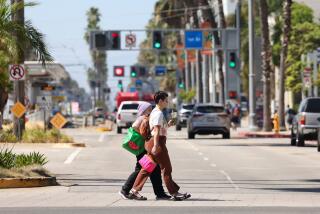SARS Outbreak Has Peaked in Most Places, Scientists Say
- Share via
As scientists are growing more confident that they have identified the cause of the mysterious pneumonia-like illness known as SARS, health authorities are saying that the worst of the outbreak is over -- at least in places other than China and Hong Kong.
“The peak in most places is behind us,” said Dr. Guenael Rodier of the World Health Organization. There might be further local outbreaks of the disease, he said, but officials in most countries are now getting the upper hand in containing the infection’s spread.
WHO said there were 59 new cases of severe acute respiratory syndrome reported through Thursday, bringing the total to 2,781 cases and 111 deaths. But 38 of those new cases were in China and Hong Kong, with only small increases reported elsewhere.
California state Health Director Diana M. Bonta said Thursday that a Santa Clara County man with SARS symptoms had tested positive for the presence of the newly identified coronavirus suspected of causing the disease, making him the first in California and only the fifth nationwide to have the infection confirmed.
The man, whose identity is being kept confidential, was hospitalized, but now is fully recovered.
There are 37 suspected cases of SARS in California among the 166 cases in the United States. There have been no deaths in this country and only one patient who was severely ill, requiring mechanical ventilation.
Florida officials are investigating what appear to be SARS symptoms in a co-worker of a SARS patient who traveled to Asia. If the disease is confirmed in the co-worker, it would mark the first time in the United States that SARS has been transmitted to anyone other than a health-care worker or a family member of a patient.
Dr. Julie L. Gerberding, director of the federal Centers for Disease Control and Prevention, said her agency is “very concerned” about the possibility of such community transmission, but she cautioned that neither of the cases has so far been confirmed to be SARS.
Researchers have suspected for some time that the disease is caused by a coronavirus, a member of a family of viruses that cause common colds and upper respiratory infections. Two teams, one from the CDC and one from Germany, reported Thursday in papers that will be published in the New England Journal of Medicine that they had isolated a novel coronavirus from tissue samples from SARS patients.
“We are increasingly confident that we are dealing with a new coronavirus, but we cannot yet say that this is the definitive cause of SARS,” Gerberding said. That will require two additional steps, she said: unequivocally identifying the virus in lung tissue from SARS victims where pneumonia is also present and developing an animal model of the disease.
She said the CDC already has sent virus samples to a laboratory in the Netherlands, where researchers are trying to infect a variety of animals.
The CDC researchers said the new virus should be named after Dr. Carlo Urbani, the WHO physician who was the first to suspect the occurrence of the disease and who died from it. They proposed that the virus be named Urbani SARS-associated coronavirus.
The teams are working feverishly to produce the full genetic blueprint of the virus, which may give clues to its origin. Most researchers believe it developed in some species of animal and was then transmitted to humans in China’s Guangdong province. Biologists hope that completing the genetic blueprint may reveal the presence of one or more genes from a specific species, enabling them to narrow the search for the origins of the virus.
Identifying the virus that causes SARS would open many possibilities, including finding drugs that will treat it and developing a vaccine. Department of Defense laboratories are already screening a large number of antiviral agents and other drugs to see whether any will halt its replication, but so far have not been successful.
Some physicians in Hong Kong and elsewhere have been treating SARS victims with the antiviral agent ribavirin, but Gerberding said Thursday that “the early results suggest ribavirin is not active,” a finding she termed “disappointing.”
She also cautioned that development of an investigational vaccine “is at least a year out.”
Gerberding said the CDC has developed three new tests for identifying the virus, two based on antibodies and one based on its genetic sequence.
The antibody tests are useful primarily in patients who are in the recovering stages of the disease and who have thus developed antibodies against the virus. They are thus most useful for confirming that a suspected case was, indeed, SARS. The CDC has distributed these tests to some state laboratories already, and they were used to identify the California patient.
The genetic, or PCR, test will be useful for identifying the virus in the early stages of an infection, allowing clinicians to rule out false cases.
Gerberding said the CDC is now gearing up to produce the special chemicals needed for the test, and should begin distributing them to state laboratories within two weeks.






